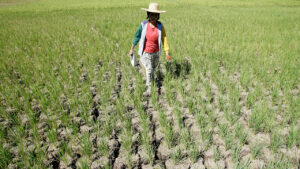




Philippines Trade Update: Trade trajectories trend along
 DOWNLOAD
DOWNLOAD

Policy Rate Updates: Double cut finale
 DOWNLOAD
DOWNLOAD

Monthly Economic Update: One for the road
 DOWNLOAD
DOWNLOAD


BSP: El Niño to weigh on inflation through 1st half

The impact of the El Niño weather event may persist throughout the first half of 2024, which could lead to higher prices of power, imported rice and food items, the Bangko Sentral ng Pilipinas (BSP) said.
The BSP in its November Monetary Policy Report said El Niño could dampen water resources and agricultural productivity next year amid expected dry spells and droughts in some parts of the country.
“The impact of El Niño is quantified through several channels including higher electricity rates due to dry weather conditions, higher domestic crop prices owing to lower production, and higher international rice prices due to lower global production and the implementation of export restrictions,” the central bank said.
“These factors are assumed to persist in the first half of 2024 and contribute to the inflation forecast for the year,” it added.
During the Nov. 16 policy meeting, the BSP raised its baseline inflation forecast to 6% in 2023 (from 5.8% in September) and to 3.7% in 2024 (from 3.5%) but trimmed its 2025 inflation estimate to 3.2% (from 3.4%).
Electricity rates could rise in the fourth quarter to the second quarter of 2024 due to the warm and dry weather conditions from El Niño, according to the BSP.
“A substantial increase in demand for power which could not be supported by power supply reserves could lead to a declaration of yellow or red alerts in the transmission grids, resulting in higher generation charges from the Wholesale Electricity Spot Market (WESM) and independent power producers (IPP),” the central bank said.
Local electric cooperatives may also have to use more expensive alternative sources of power generation amid the expected drop in output from hydropower plants.
“A 3% month-on-month increase in electricity prices is assumed for the period January to June 2024. This is based on the average increase in the overall electricity rate during the El Niño episode in 2018-2019,” the BSP said.
Meanwhile, temperature shocks may have a significant negative effect on rice and corn, which accounted for about 8.9% and 0.5% of the consumer price index (CPI) basket, respectively.
El Niño could also lead to stronger demand for rice globally, particularly for imports from Vietnam and Thailand. However, the global rice supply is also vulnerable to El Niño and possible trade restrictions.
“With much of the increase having taken place in the first half of the year due to the combined factors of strong demand and tight supply conditions as well as concerns over El Niño conditions in most of Asia’s rice producers, rice prices on average are seen to be higher. Higher rice prices are assumed starting January 2024,” the BSP said.
China Banking Corp. Chief Economist Domini S. Velasquez in a Viber message said there would be some tightness in food supply through mid-2024 due to El Niño.
“We think that one of the reasons that the BSP continues to remain hawkish is because of the continued threat to food supply/prices in the near term,” she said.
The BSP kept its benchmark interest rate steady at a 16-year high of 6.5% at its policy meeting last week. Since it began its aggressive monetary tightening cycle in May 2022, the BSP has raised borrowing costs by a total of 450 basis points.
Ms. Velasquez noted that historically, prices of food have increased during El Niño or La Niña episodes. Since the current El Niño episode has been expected, she said governments should implement appropriate measures to mitigate the impact.
“Across Asia, countries have been bracing themselves for El Niño’s impact. In fact, in Thailand, the Thais are encouraged to conserve water,” she added.
Federation of Free Farmers National Manager Raul Q. Montemayor said rice crops would need large amounts of water in the planting season between now and February 2024. Farmers would also heavily rely on irrigation during the dry season.
“El Niño may affect the availability of irrigation water if there is insufficient rain, given that irrigation ranks next to potable water use and electricity generation in terms of priority,” he said. “By March next year, farmers will start harvesting and little rain at this time would be ideal since harvested stocks will not have to be dried much.”
In the BMI Southeast Asia El Niño Exposure Index released in July, the Philippines ranked sixth most vulnerable to El Niño-induced inflationary pressures among 13 countries.
National Economic and Development Authority Secretary Arsenio M. Balisacan earlier said a “slight El Niño” could cause agricultural production to decline by 1-2%.
The Philippines experienced its worst El Niño episode in 1998, when the economy contracted by 0.5% as agricultural production fell by 7%. — By Keisha B. Ta-asan, Reporter
This article originally appeared on bworldonline.com





 By BusinessWorld
By BusinessWorld